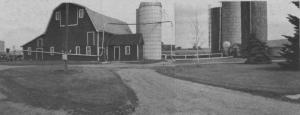1984 - Volume #8, Issue #4, Page #07
[ Sample Stories From This Issue | List of All Stories In This Issue | Print this story
| Read this issue]
Air System Moves Silage
 |
"Commercial pneumatic systems can't handle corn silage or haylage because the stems have problems going through the air-lock systems and plug up," explains Hellerman, who's tested the air system for 2¢ years on his own farm.
He runs silage 112 ft. through 4 in. aluminum tubing from the silo to an ensilage mixer in a feed room. "Without the air system," says Hellerman, "It would take 3 conveyors to reach the mixer."
To prove the air system's effectiveness, Hellerman designed a special pipe "test course." He ran 235 ft. of pipe from the silo to the far side of his barn, putting five 90? turns plus a 26 ft. lift into the line to see if corn silage would move through the system. It did at the rate of 3Minnesota farmer John Heller-man, of Melrose, has invented a new "Forage Convey Air System" that transports corn silage, haylage, shelled corn and other grains.
"Commercial pneumatic systems can't handle corn silage or haylage because the stems have problems going through the air-lock systems and plug up," ex-plains Hellerman, who's tested the air system for 2¢ years on his own farm.
He runs silage 112 ft. through 4 in. aluminum tubing from the silo to an ensilage mixer in a feed room. "Without the air system," says Hellerman, "It would take 3 conveyors to reach the mixer."
To prove the air system's effectiveness, Hellerman designed a special pipe "test course." He ran 235 ft. of pipe from the silo to the far side of his barn, putting five 90? turns plus a 26 ft. lift into the line to see if corn silage would move through the system. It did at the rate of 3Minnesota farmer John Heller-man, of Melrose, has invented a new "Forage Convey Air System" that transports corn silage, haylage, shelled corn and other grains.
"Commercial pneumatic systems can't handle corn silage or haylage because the stems have problems going through the air-lock systems and plug up," ex-plains Hellerman, who's tested the air system for 2¢ years on his own farm.
He runs silage 112 ft. through 4 in. aluminum tubing from the silo to an ensilage mixer in a feed room. "Without the air system," says Hellerman, "It would take 3 conveyors to reach the mixer."
To prove the air system's effectiveness, Hellerman designed a special pipe "test course." He ran 235 ft. of pipe from the silo to the far side of his barn, putting five 90? turns plus a 26 ft. lift into the line to see if corn silage would move through the system. It did at the rate of 3¢ tons per hour. Haylage capacity is lower.
The air system is ideal for farms where you need to move feed to a distant area and where conveyors would be too costly and difficult to put up and maintain, says Hellerman. Another advantage is that if there is a breakdown, maintenance is in one easy-to-reach location. Also, by putting a flex tube on the discharge, you can have pipes running to separate groups of livestock.
The key to Hellerman's air system is the air lock, which he explains, works much like a revolving door, to move material into the air flow without losing air pressure.
Air flow is generated by a 7¢ hp. motor powering a blower with a 4 lb. per sq. in. maximum air pressure rating. This air is forced through a tube picking up the material from the air lock and exiting into the 4 in. pipe.
The air lock consists of 2 rotors, powered by a 1¢ hp. motor, that pack the material, and feed it into the air flow. The top rotor, with a 6¢ in. dia., turns at about 500 rpms while the bottom rotor, with rubber tip paddles, is 16 in. in dia. and moves at 10 rpms.
Hellerman notes that the unit can be moved to other sites as needed. He's working on getting the unit into commercial production, estimating that the price would be competitive with running a conveyor 100 ft.
Contact: FARM SHOW Followup, John Hellerman, R.R. 2, Box 78, Melrose, Minn. 56352 (ph 612 256-4433).

Click here to download page story appeared in.

Click here to read entire issue
To read the rest of this story, download this issue below or click here to register with your account number.




